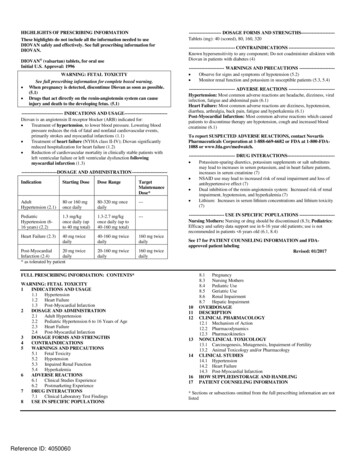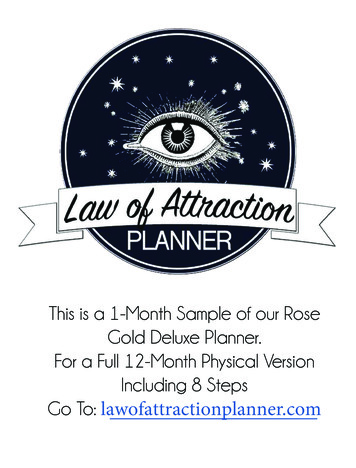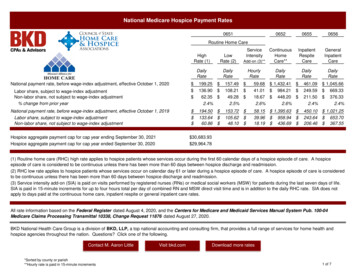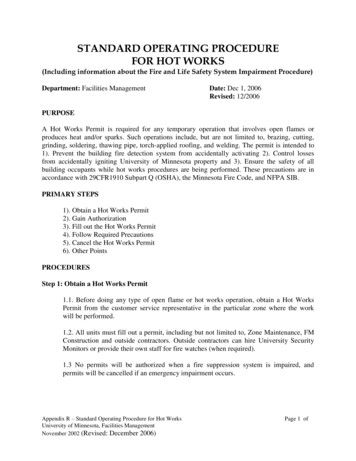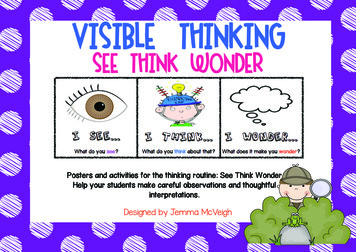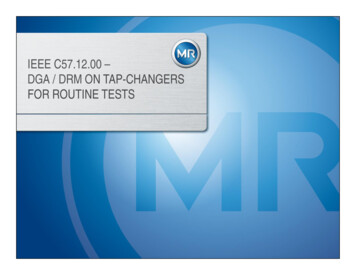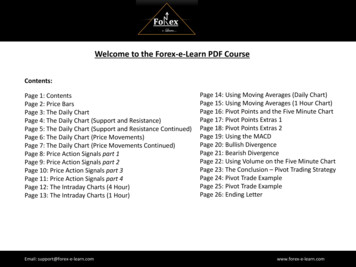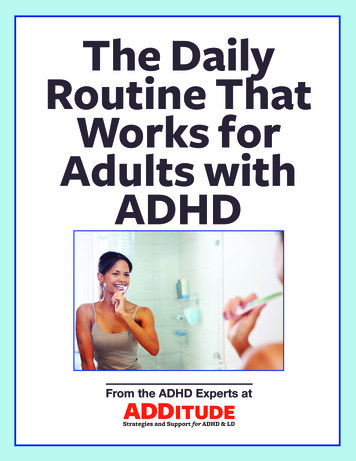
Transcription
The DailyRoutine ThatWorks forAdults withADHDFrom the ADHD Experts at
A trusted source of advice and information for families touched by attention-deficit disorder—and a voice of inspiration to help people with ADHD find success at home, at school, and on the job.ADDitudeMag.comTERMS OF USECopyright 2016 by New Hope Media. All rights reserved.No part of this report may be reproduced or transmittedin any form or by any means, electronic or mechanical, including photocopying, recording, faxing, e-mailing, posting online, or by any information storage and retrieval system, without written permission from the Publisher.All trademarks and brands referred to herein are the property of their respective owners. All references to ADDitudemagazine, ADDitudeMag.com, and ADDConnect.comare trademarks of New Hope Media.CONTACT INFORMATIONNew Hope Media – 646-366-0830108 West 39th St, Suite 805New York, NY 10018LEGAL NOTICESADDitude does not provide medical advice, diagnosis ortreatment. The information offered here is for informational purposes only and is not intended to substitute orreplace professional medical advice, diagnosis, or treatment. Always consult with your physician or other qualified health-care professional or educational consultantfor questions about the health and education of you, yourchild, and family members. Do not disregard, avoid or delay obtaining medical or health related advice from yourhealth-care professional because of something you haveread here.If you think you may have a medical emergency, call yourdoctor or 911 immediately. ADDitude does not recommend or endorse any specific tests, physicians, products,procedures, opinions, or other information that may bementioned in ADDitude publications or web sites. Reliance on any information provided by ADDitude is solely atyour own risk.Founder: Ellen Kingsley (1951-2007)Editor In chief: Susan CaughmanEditor: Wayne Kalynstaffconsulting creative Director: Susan Dazzoconsulting art Director: Ron AnteroinenManaging Editor: Eve GilmanASSISTANT editors: Devon Frye, Janice RoddenSocial Media editors: Rebecca Brown Wright, Penny WilliamsDigital Marketing Director: Anni RodgersDigital Marketing Manager: Kate HarmsworthAdvertising: Anne MazzaCirculation: Sue SidlerCopy Editor: Gene Jonescontributing Editors:Carol Brady, Ph.D., and John Taylor, Ph.D. (Children)Edward M. Hallowell, M.D. (Life)Sandy Maynard, M.S. (Coaching)Michele Novotni, Ph.D. (Adults)Ann Dolin, M.Ed., and Sandra F. Rief, M.A. (Education)administrative assistant: Madalyn Baldanziscientific advisory boardRussell Barkley, Ph.D.Medical University ofSouth CarolinaCharleston, SCCarol Brady, Ph.D.Baylor College of MedicineHouston, TXThomas E. Brown, Ph.D.Yale UniversitySchool of MedicineNew Haven, CTPeter Jensen, M.D.The REACH InstituteNew York, NYHarold Koplewicz, M.D.New York UniversityMedical SchoolNew York, NYSandy Newmark, M.D.Osher Center forIntegrative Medicine,University of CaliforniaSan Francisco, CAWilliam Dodson, M.D.ADHD Treatment CenterDenver, COMichele Novotni, Ph.D.The Villages, FLEdward M. Hallowell, M.D.The Hallowell CenterSudbury, MARoberto Olivardia, Ph.D.Harvard Medical SchoolBoston, MAPeter Jaksa, Ph.D.ADD Centers ofAmericaChicago, IL
The Daily Routine That Worksfor Adults with ADHDKeys-wallet-phone. It’s our get-out-the-door mantra, and it really works. Here aremore schedules, routines, and systems that, when practiced religiously, help tokeep our days humming along.By the Editors of AdditudeChildren with ADHD thrive when they stick close to daily routines andschedules. This is hardly news, but it might surprise you to learn the same istrue for adults with attention deficit.The fact is, the most organized, on-time people you know all have one thingin common: They do the same tasks in the same order, each and every day.We wouldn’t blame you for mistaking unmovable daily routines for boringtedium — especially if you thrive on the new and the novel. But the resultsspeak for themselves: Set up reliable routines for the more mundane aspectsof your life – getting ready for work, making dinner, getting to bed on time– and you’ll free up important time to enjoy the rest of your life, withoutfeeling guilty about putting off the laundry or oversleeping again. Here ishow to do it.How to Build a RoutineThe goal of any good routine is to make certain behavior patterns into habitsthat you practice until they become second nature. It takes a few weeks (ormonths) of everyday use for any action to become internalized. In the meantime, use these steps to create and stick to your new routines.1. Post the steps of your routine where you can see them. If you wantto prepare lunch before bed, put a list on the refrigerator. If you3from the editors of
want to lay out your clothes the night before, post a reminder onyour bathroom mirror where you can’t ignore it.2. Set a watch or phone alert to go off five minutes before you’rescheduled to begin a new task. That will give you time to finishwhatever you are working on, and refocus. You may also need reminders to help you stay on track.3. Set a day to start over. If you fall off on your routine because ofvacation, a houseguest, or an unexpected event like an illness, marka day on the calendar when you’ll pick up where you left off. Youdon’t have to be perfect every day to make a difference in your life.4. Start small. If creating a whole new life routine at once feels liketoo much, pick one small thing – like making the bed or sorting themail – that will make your day easier when done regularly. Figureout an easy way to do it. Will you throw out junk mail immediatelyinstead of dropping it in a pile? Will you open bills and put themwith your keys so you remember to pay them the next day? Whenyou consistently do this for two weeks, add another tiny thing. Before you know it your larger routine will change.“You won’t get it 100percent right everytime. But you’ll bebetter off than youwere before.”—Dana Rayburn,ADHD Coach5. Don’t give up. If you have a hard time with a part of your routine,try doing it a different way. More often than not, just a tiny tweakcan make a difference. If you can’t seem to plan your meals onSunday night, for example, try Tuesday evenings when the grocerystore is empty.MorningThe AM hours are not often our favorite time of day. We’re naturally nightowls, and can have trouble falling sleep, so dragging ourselves out of bed inthe morning is a chore.But how you start the morning can set the tone for your entire day. If you areconstantly rushing into work a few minutes late, you don’t have time to stop,think, and focus on priorities. You’re harried, stressed, and flustered.Instead, use these steps to bring a little peace to your morning.1. Get up 15 minutes before anyone else. Sure, it’s the last thing inthe world you want to do, but having a small space of time can letyou shower, dress, and have a cup of coffee before you have to toastanyone’s bagel or brush anyone’s hair.Works for Adultswith ADHD2. Invest in a good alarm clock. Try one of our ADHD-approvedfrom the editors of4The DailyRoutine That
devices like Clocky that will force you out of bed to chase it, or theSonicBomb that vibrates your mattress.3. Open the shades. As soon as you get out of the bed, let natural lightinto the room, or if it’s dark when you go to bed, leave the curtainsparted so the sun can nudge you into waking up.4. Set a time to leave the house, and announce it. Start with whattime you need to be to work, or drop the kids off at school. Workbackward with how long it takes to get there, load everyone into thecar, and get on the road.Wake up! ADHDFriendly Alarm Clockshttp://attitu.de/ce5. Build in an extra 15 minutes in case something goes wrong. Beingearly is not a bad thing if everything goes as planned. It lets youstart the day on a calm note, and avoid rushing and forgetting.6. Don’t turn on the TV or computer. Even if you just plan to catchthe day’s weather report, it’s easy to get interested in a program andlose track of time.7. Consider an early morning dose of medication. If you take anADHD medication, ask your doctor about taking a minimal dose ofshort-acting medication before you need to get out of bed, and thenresting until your second alarm goes off. This dose should supplement your regular morning pills.8. Keep your weekend routine the same. It’s tempting to stay up lateand sleep in on Saturdays and Sundays, but it only makes it harderto get back on track when Monday inevitably rolls aroundSample morning routine6:30 am – Wake up6:35 am – Get ready: Shower, get dressed, make coffee7:05am – Wake up your kids/spouse7:15am – Breakfast time7:45am – Brush your teeth7:55am – Pick up everything at your launch pad8:00am – Out the door!The DailyRoutine ThatWorks for Adultswith ADHDfrom the editors of5
At WorkBeing productive at work means managing time, setting priorities, and resisting the distractions that make us forget what we were trying to do.Stay on task with these routines, and a few ground rules.1. Use the first 15 minutes of the day as a planning period. Look at yourto-do list to figure out the Top 5 most important things to complete bythe end of the day. Mark timeslots on your calendar to work on eachthing. Set a timer when you tackle each task to remind you when it’s timeto change to the next item. Use a dry-erase board so you can update yourlist throughout the day as your priorities change.2. Schedule the bigger, harder tasks for the morning when you have themost attention. Break them into manageable chunks you can work onthroughout the day. Leave smaller, easier-to-accomplish tasks for the afternoon, when you are tired.Free Resource:ADHD Career SuccessGuidehttp://attitu.de/career3. Don’t check your email first thing. Instead of setting your own priorities, this makes you react to what other people need. Check email afteryou have created a plan for the day and know when you have free time.4. Schedule times to check email. Constantly checking it whenever a newmessage pops into your inbox can distract you from the task you areworking on and make it hard to get anything done. Instead, respond toemails in groups at 10 am, 1 pm, 3 pm, and before leaving for the day.5. Bring in a fidget. Doing two things at once can help focus the ADHDbrain on a primary task. A stress ball or Bucky balls can help keep yourmind focused on desk work while your hands move. Or, listen to musicin your headphones while you work to keep your mind engaged.6. Replace negative self-talk. Instead of thinking, “This will take forever,and it’s already late ” think, “I might not be able to finish this today,but in the next hour, I can do the first two steps so there is not as muchtomorrow.” This approach can diminish procrastination and guilt.7. Just do it. Even if your first try is sloppy and needs lots of revision, it isbetter than a blank document. Instead of worrying that you first draftisn’t perfect, just start capturing thoughts and go from there. Often onceyou get started, momentum will carry you on.The DailyRoutine ThatWorks for Adultswith ADHDfrom the editors of6
Sample Work Routine9:00am – Review your tasks for the day. Create a schedule totackle the top 5.9:15am – Task 110:00am – Check email10:15am –Task 211:00am – Activity Break! Walk up and down a few flights ofstairs or get a glass of water and do a crossword puzzle11:15am – Task 312:00pm – LunchFree Resource:Eat Healthier, Feel Betterhttp://additu.de/10j1:00pm – Check email1:15pm – Task 42:00pm – Talk a short walk, and clear your desk of loose papers2:15pm – Task 53:00pm – Check email3:15pm – Work on small, easy tasks4:45pm – Check email5:00pm – Head home. Check to make sure you have everything you need before leaving your desk.DinnerAt times, dinnertime feels like a three-ring circus with kids demandingsnacks, art projects cluttering the dinner table, or a last-minute rush to thegrocery store. Avoid all of that with these strategies.Meal planning can seem like a chore – decision-making, planning, prioritizing, and then navigating the supermarket. Instead, think of it as an exercisein creativity – figuring out what you can make from the ingredients in yourhome, or getting the most meals out of one common ingredient.The DailyRoutine ThatWorks for Adults1. Plan out meals for the week. Before going grocery shopping, sit down with ADHDand figure out what you want to eat for breakfasts, lunches, and dinners7from the editors of
throughout the week. Gather recipes and make a list of things to buy. Putit on your launch pad, and when you get to the grocery store, only buythings that are on the list.2. Create a “Top 10” dinner list. You can use these recipes in 5-day cyclesover two weeks. It allows for some variety, and a couple nights of ordering in or eating out without getting bored eating the same thing.3. Write your menus on individual index cards. Put these in a sequence,so you have the recipe and ingredients handy when you are ready to startcooking. Arrange them in an order that allows you to use leftover ingredients from one meal to start the next day’s dinner.4. Prep foods the night before, or when you get home from the grocerystore. If you will be using fresh vegetables, rinse and chop them beforeputting them away. Toss ingredients in a slow cooker that you can turnon in the morning so that dinner is halfway there before the eveningrush. Take out frozen ingredients for tomorrow’s dinner when you’remaking dinner tonight.“The brilliance lies inhaving the mundaneaspects of life takencare of, so you canrelax and have somefun. Isn’t that whatwe all want?” – MarlaCilley, The FLY Lady5. Involve your family. If you have kids or a spouse, ask them to set thetable while you finish up cooking. Or, have them clear the table and loadthe dishwasher when dinner is over.6. Cook in double. If you double a recipe, you can freeze portions to eat ona free night, or on a night when you’re just too busy to cook.Sample dinner routine5:45 pm – Start food prep6:30 pm – Set the table, and pour beverages6:45 pm – Dinner is served7:15 pm – Clear the table and load the dishwasher7:30 pm – Relax and do something you enjoyThe DailyRoutine ThatWorks for Adultswith ADHDfrom the editors of8
BedtimeAfter a long day at work, many adults with ADHD are wound-up, and can’tturn off their racing brains by the time lights-out rolls around. The key is tostart planning to go to bed long before the clock chimes 10. A reliable andconsistent pattern can help you reset your mind to get ready for sleep eachnight, and wake up physically and mentally refreshed.An organized morning begins the night before, and here is what it lookslike:1. Lay out your clothes for tomorrow. Set a timer, and turn picking outan outfit into a fun game. Pick out every little bit you need right downto underwear, socks, accessories, and shoes.2. Create a “launch pad.” Designate an area by the front door where youplace everything you need to bring with you when you walk out to yourcar each day. Place briefcases, purses, keys, and dry cleaning receipts alltogether there. It gives you a place to put things you need, saves timerunning around looking for what you need, and cuts down on morningpanic/forgotten items.ADHD Bedtime Rituals:The Do’s and Don’ts ofSleephttp://attitu.de/1k3. Set the stage for breakfast. Fill the coffee pot and program it to brewwhile you’re getting dressed. Place a clean mug next to it, and set thetable with any dishes you’ll need and any unrefrigerated food items.4. Prepare your lunch. If you bring lunch to work, put it in a containerready to grab and take to work. If you buy lunch, make sure you haveenough cash to pay for it.5. Log off the computer, put your phone away, and turn off the TV anhour before bed. Studies show that using electronic devices wakes thebrain up instead of preparing it for sleep, and the light they emit candisrupt circadian rhythms. Try a quiet activity like reading.6. Get kids into bed, or at least ready for bed and in their rooms, an hourbefore you want to go to sleep. You need some off-duty time to rest andwind down before conking out for the night.7. Take a hot bath or shower. In the evening, you won’t feel so rushed toget out the door, and there’s a lower chance someone else will need thebathroom. When your temperature gradually drops, it helps you to feelsleepy. It’s a great natural relaxing agent.8. Go to bed! Prioritize getting eight hours of sleep each night. Catchingenough Zzzzs is essential for anyone with ADHD.The DailyRoutine ThatWorks for Adultswith ADHDfrom the editors of9
sample bedtime routine9:00pm – Put away electronic devices9:05pm – Lay out clothes9:15pm – Get breakfast and lunch ready9:30pm – Take a shower or a relaxing bath9:50pm – Brush teeth10:00pm – Get in bed and read quietly for half an hourWhat a Nightmare!More on Common SleepProblemshttp://additu.de/29The DailyRoutine ThatWorks for Adultswith ADHDfrom the editors of10
ADDitude Special ReportsAvailable Nowwww.adhdreports.comFREE ADDitudeDownloadableBookletsADHD 101Does Your Child Have aLearning Disability?A complete overview of ADHD, outlining every step from diagnosis totreatment—all the way to living successfully with attention deficit.From the moment you suspect ADHD in yourself or your child, you havehundreds of questions. Which doctors can evaluate symptoms? What medication side effects should you be prepared for? Can diet help? This comprehensive eBook has over 100 pages of expert advice, personal stories, andmore to help you become an ADHD expert. Learn More About This Special Report: http://additu.de/adhd-1019 Conditions Often Diagnosed with ADHDDepression. Bipolar Disorder. Anxiety. OCD. And five more conditionsthat often show up alongside attention deficit.About 80 percent of individuals with ADHD are diagnosed with at least oneother psychiatric condition at some time in their lives. This in-depth special report looks at the nine most common, outlining symptoms, treatmentstrategies, and differentiating features of each. Plus, strategies for living wellwith any mental health condition.Use this self-test to find out ifyour child’s problems at schoolmay be due to LD.Is It Depression?Depression is a serious mooddisorder, but it’s not always easyto recognize.Who Can Treat ADHD?Doctor? Psychiatrist? Coach?Learn who can treat your attention deficit.You Know You Have ADHDWhen Real ADHDers share personal stories highlighting the lighter side ofliving with attention deficit.Is It Adult ADHD? Learn more about this special report: http://additu.de/relatedHabitually disorganized? Alwaysrunning late? It could be ADHD.Mindfulness and Other Natural TreatmentsHomework Help for ADHDChildrenThe best non-medical treatments for ADHD, including exercise, greentime, and mindful meditation.Learn how mindfulness works on ADHD brains, and how to begin practicing it today. Plus, research the benefits of other alternative treatments likeyoga and deep breathing exercises—including some designed especially forkids—as well as the science behind each natural therapy. Learn more about this special report: http://additu.de/mindfulnessTo purchase these or other ADDitude Special Reports, go towww.adhdreports.com11Addressing homework problemsis critical – here’s how to do it.Smart ComebacksWitty responses to ADHDdoubters.Find these and manymore free ADHDresources online at:http://additu.de/freedownloads
FREE ADHD Webinar Replaysfrom ADDitude:Neurofeedback and Cognitive Training for ADHD Kids http://additu.de/neuroIs brain training—including neurofeedback and cognitive training (CT)—really all it’s cracked up to be? Is it safe for kids? Is it worth the money?Naomi Steiner, M.D., shares the research behind some computer-based alternative therapies so you can make an informed decision before treatingyour child.Healing the ADHD Brain: Interventions and Strategiesthat Work http://additu.de/healingThere’s no one-size-fits-all approach for treating ADHD. Here, Daniel G.Amen, M.D., explains treatment options ranging from medication and supplements to diet and exercise.The Truth About Obsessive-Compulsive Disorder http://additu.de/barkleyThere are lots of misconceptions surrounding OCD and ADHD, especiallywhen the conditions coexist. In this webinar, host Roberto Olivardia, Ph.D.,sets the record straight about this potentially debilitating condition. Learnthe truth about obsessive-compulsive disorder, so you (or your child) canget the right diagnosis and receive the proper treatment.7 Fixes for Self-Defeating ADHD Behaviors http://additu.de/brownAre your bad habits setting you up for failure? Find out what behaviors towatch for, and seven simple changes that can help you reach your full potential and put you on the path to success. Entrepreneur and ADHD coach AlanBrown teaches “fix-it” strategies that he used to cope with his own ADHD.Mastering ADHD Medications http://additu.de/22Dr. William Dodson, a board-certified adult psychiatrist who specializes intreating ADHD, discusses the many medication options for ADHD and howeach one works. Learn about choosing a medication, minimizing side effects, and finding the right dosage for yourself or your child.12FREE ADHDNewsletters fromADDitudeSign up to receive critical news and informationabout ADHD diagnosis andtreatment, plus strategiesfor school, parenting, andliving better with ADHD:http://additu.de/emailAdult ADHD and LD (weekly)Expert advice on managing yourhousehold, time, money, career,and relationshipsParenting ADHD and LDChildren (weekly)Strategies and support for parents on behavior and discipline,time management, disorganization, and making friends.ADHD and LD at School(bimonthly; weekly fromAugust through October)How to get classroom accommodations, finish homework,work with teachers, find the rightschools, and much more.Treating ADHD (weekly)Treatment options for attentiondeficit including medications,food, supplements, brain training,mindfulness and other alternativetherapies.
6 fr f TERMS OFUM CNAIOLRMTE IM GNdvyMbNdMHoAFIyM wOIEMHStS At Work Being productive at work means managing time, setting priorities, and re-sisting the di

